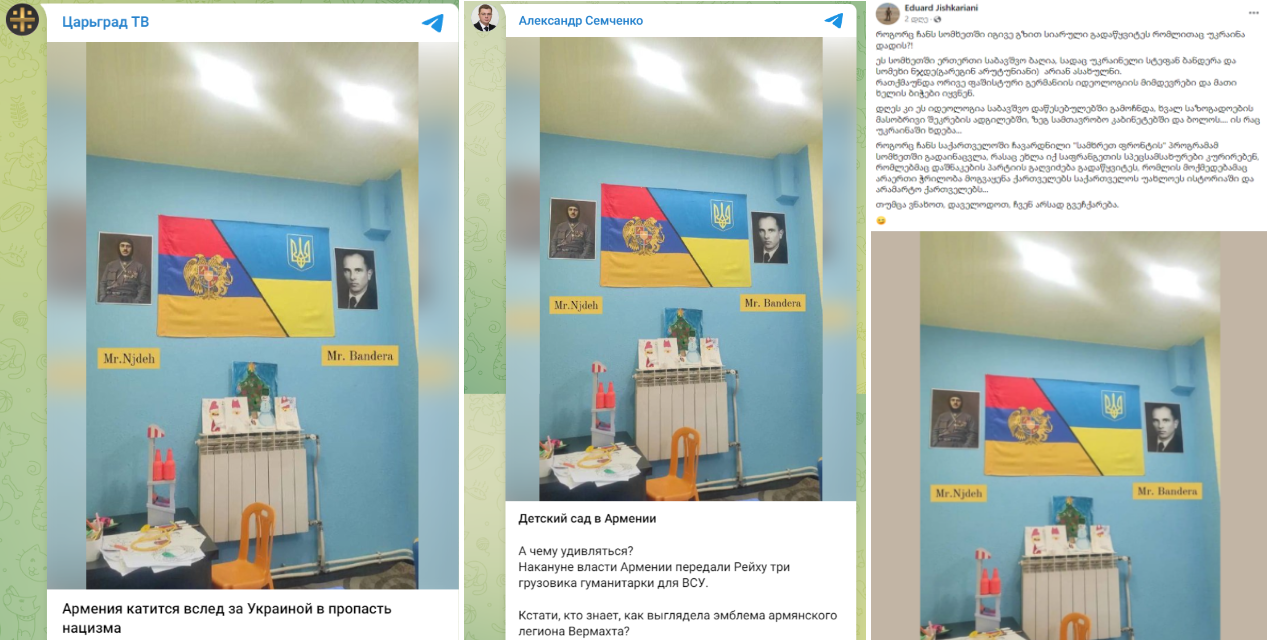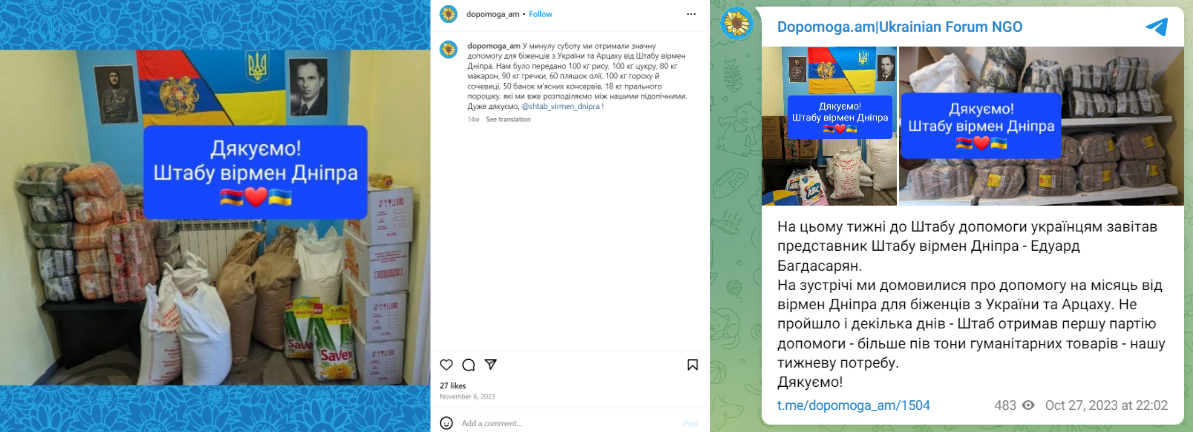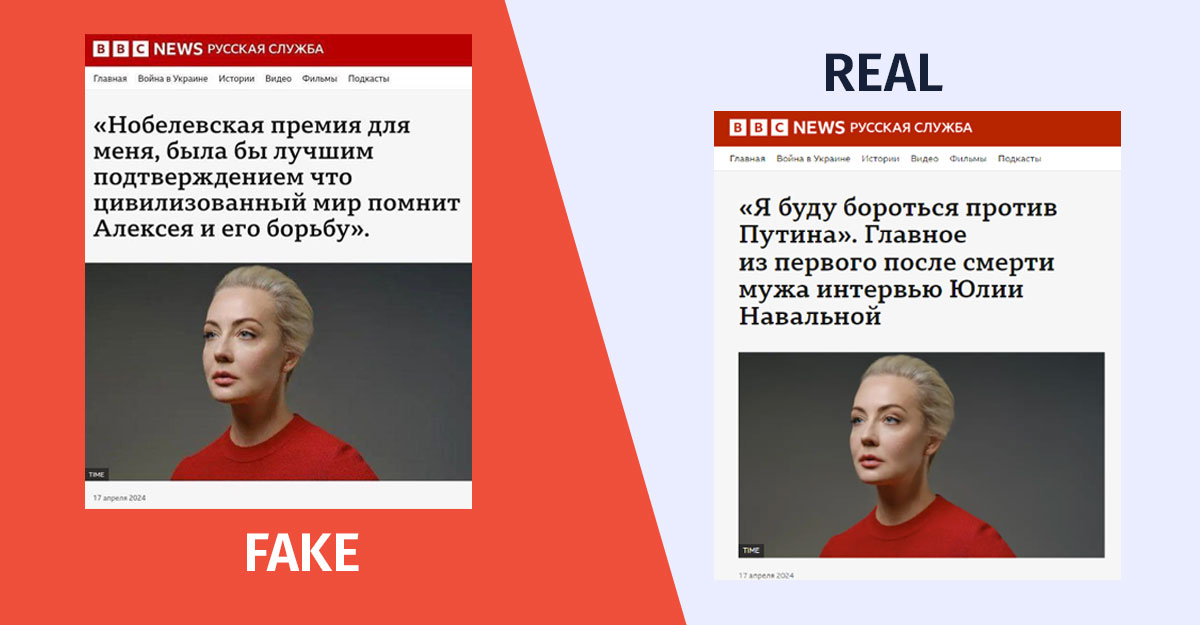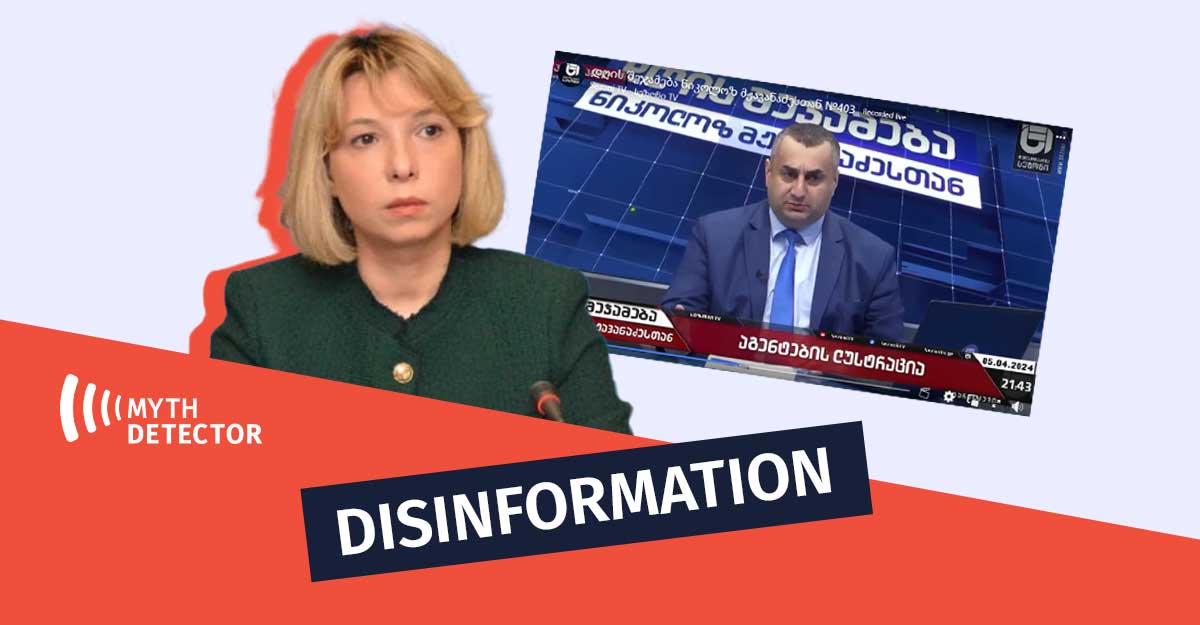On February 11, Facebook user Eduard Jishkariani published a photo in which portraits of Ukrainian Stepan Bandera and Armenian Garegin Nzhdeh, as well as a combined Armenian and Ukrainian flag, are hanging on the wall. According to the posted message, the photo was taken in a kindergarten in Armenia. “It seems that the ‘South Front’ program, which fell through in Georgia, has moved to Armenia and is now run by French special services there,” the message read.
A photo with a similar message was posted by Russian-language Facebook accounts (1, 2, 3), as well as by the Russian Tsargrad TV channel. An identical photo was shared on the Telegram channel by Aleksandr Semchenko, a Russian political commentator and blogger. In the description of the photo, he said that the content of the photo was not surprising, especially after the Armenian government, a day earlier, transferred trucks with humanitarian aid to Germany to assist the armed forces of Ukraine.
The photo showing portraits of Stepan Bandera and Garegin Nzhdeh was disseminated manipulatively. In reality, the photo was taken not in a kindergarten but in the aid center for Ukrainian refugees in Yerevan. The photo was posted on Instagram by a journalist from the Armenian media outlet CivilNet.
Dopomoga is the aid center for refugees from Ukraine and Nagorno-Karabakh in Yerevan. The photo was taken there. Portraits of Bandera and Nzhdeh can be seen in a number of photos posted by the Center on Instagram and Telegram channels.
To verify the photo and obtain additional information, Myth Detector contacted CivilNet, an Armenian media outlet and member of the International Fact-Checking Network (IFCN). According to the editor-in-chief, the photo circulating on social media was first taken by their journalist at the Dopomoga center, who posted it to Instagram Stories and also wrote the names Bandera and Nzhdeh under the portraits, respectively. Journalist Ana Eganyan posted the photo on February 9.
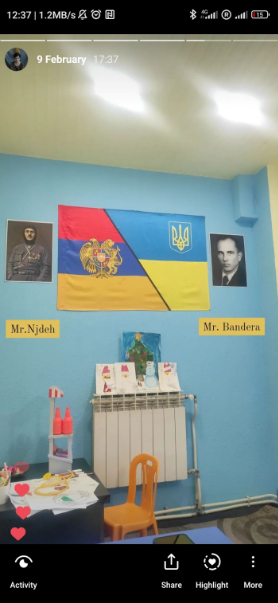
The photo with a false description as if it were taken in an Armenian kindergarten was first shared by an Azerbaijani Telegram channel, Без Тормозов (“Without Brakes”). The Telegram channel claimed that children in Armenian schools have been taught fascist ideology from the very first day and demanded that the photo be disseminated in the Russian segment of Telegram.
Garegin Nzhdeh was an Armenian military leader, nationalist, and member of the Armenian Revolutionary Federation known as Dashnaktsutyun. He fought against Turkish, Azerbaijani, and Bolshevik forces. There are different opinions regarding his collaboration with Germany during World War II. In the early 1940s, Garegin Nzhdeh cooperated with the Nazi regime in Germany and fought in the Armenian legion of the Wehrmacht, hoping that Germany would win the war and Armenia would gain independence. Garegin Nzhdeh was imprisoned several times in Soviet prisons. The last arrest took place in Sofia, at his home, on charges of killing Bolshevik military officers and fighting with Nazi Germany against the Soviet Union. Nzhdeh was initially held in Vladimir prison, then spent a year in Yerevan prison, where he died. Garegin Nzhdeh was named a national hero of Armenia. In 2016, Russia expressed its disapproval of the installation of a statue of Nzhdeh in Yerevan.
As for Ukrainian Stepan Bandera, he was a member of local nationalist organizations after World War I, fought for Ukrainian independence in 1930s and 1940s, and was held in Soviet prisons. When the Nazis invaded Poland, Bandera and his followers escaped from prison and then helped the Third Reich Wehrmacht confront Soviet spies in Poland and Ukraine.
Bandera’s goal was to liberate Ukraine and establish an independent state, and he signed an agreement with Germany to this end. However, Nazi Germany later rejected the Ukrainian independence plan and, in 1941, imprisoned Bandera in the Sachsenhausen concentration camp, where he was held until September 1944. Bandera remains a controversial figure to this day, even in Ukraine.
Stepan Bandera’s name and biography have been repeatedly used by the Kremlin to discredit Ukraine. Read about what Russian propaganda spread about Stepan Bandera in the Myth Detector’s article:
About the source:
Facebook user Eduard Jishkariani frequently disseminates anti-Wester and anti-Ukrainian content, as well as disinformation and manipulative news. In the past, Myth Detector has repeatedly checked false information spread by Jishkariani.
Archive links: Eduard Jishkariani, Царьград ТВ, Александр Семченко, Без Тормозов, Dopomoga.
The article has been written in the framework of Facebook’s fact-checking program. You can read more about the restrictions that Facebook may impose based on this article via this link. You can find information about appealing or editing our assessment via this link.
Read detailed instructions for editing the article.
Read detailed appeal instructions.


















